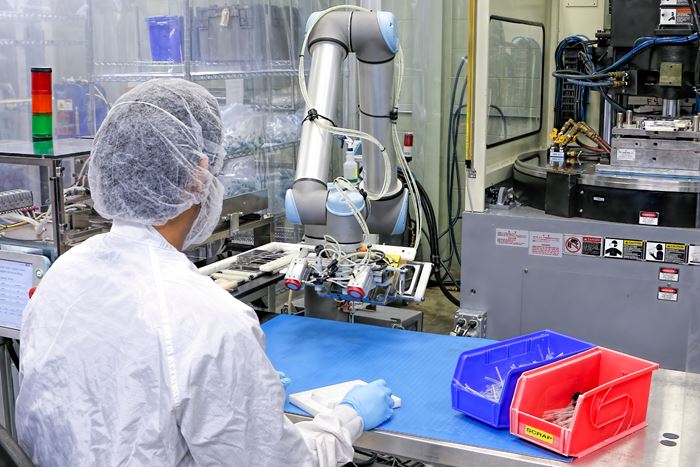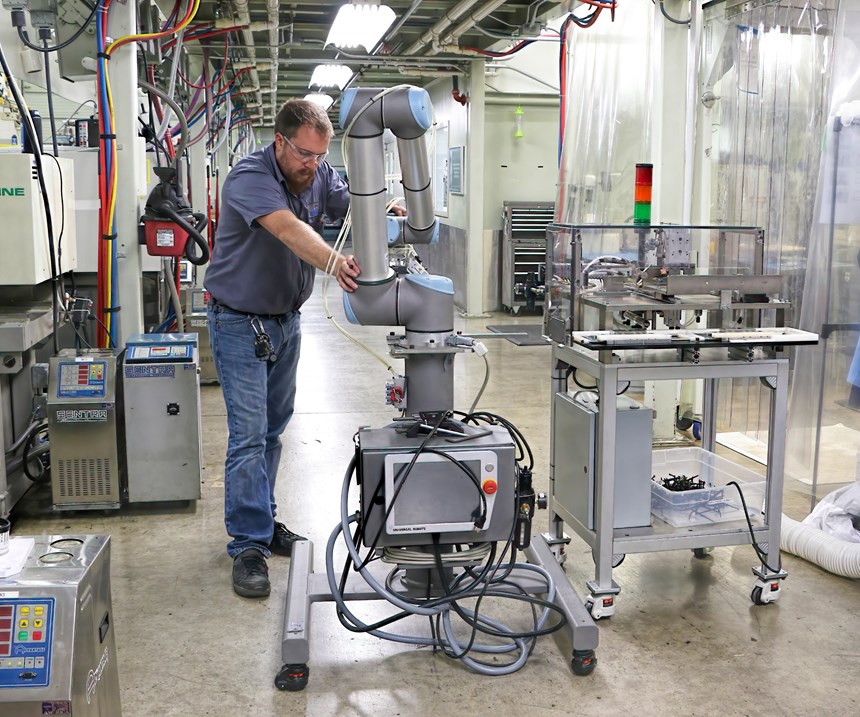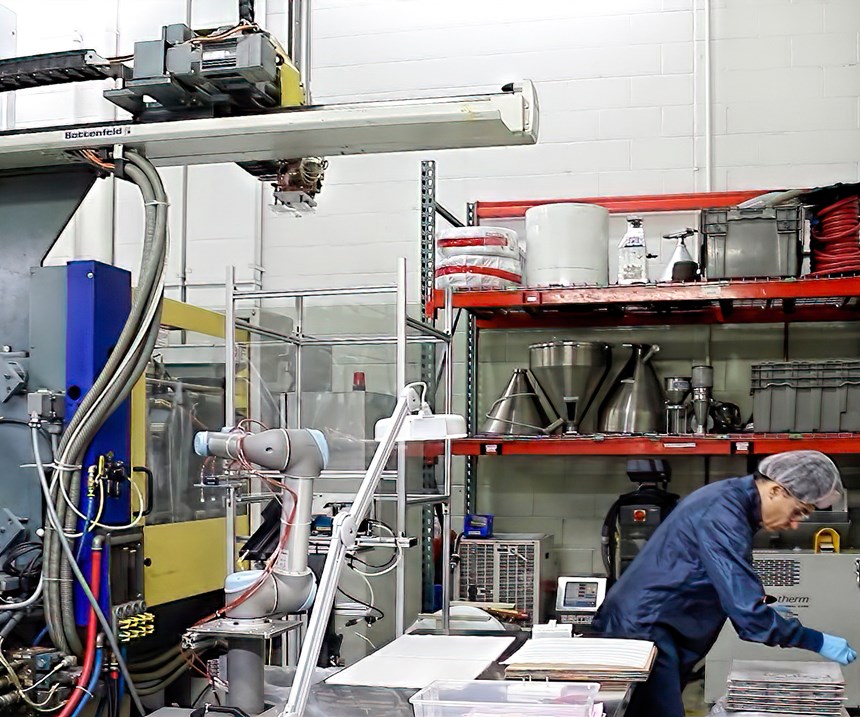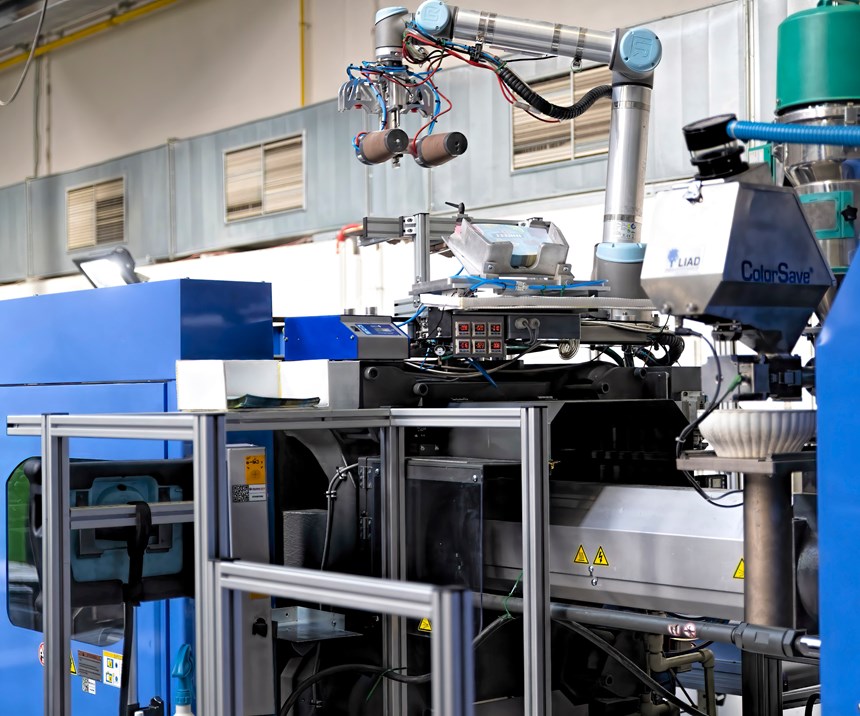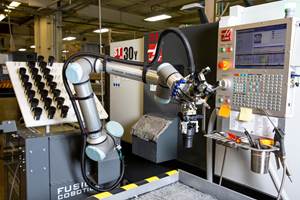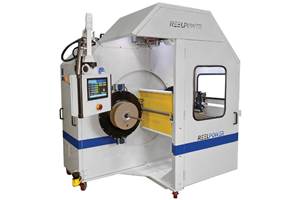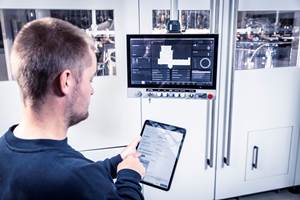Thirty years ago, fully servo-controlled robots of any kinematic configuration were rarely deployed in injection molding applications. The most common approach was to deploy a simple three-axis, point-to-point Cartesian robot that was machine mounted. With enough Z (vertical) stroke to reach the centerline of the platen, these very simple robots quickly extracted parts from the mold and delivered them to totes or conveyors.
Twenty years ago, fully servo-controlled Cartesian robots became common, providing greater precision and control of the end-of-arm tools. Fifteen years ago, molders began applying six-axis robots in increasing numbers. This evolution was driven by several technical and business drivers that continue today:
• Post-mold processes. Customers are requiring molders to deliver more complete parts and assemblies, and molders are glad to increase their value. Degating, trimming, polishing, decorating, assembly, wrapping and packaging are now common tasks that are perfect candidates for automation.
• Improved surface finish. Customers are setting very high standards for surface finishes, which require parts to be handled carefully from the mold to the final package or shipping container.
• Shorter product life cycles. The pace of product updates and new introductions requires constant change in manufacturing processes.
• High mix/low volume. Product customization, small lot sizes and on-demand production to reduce inventory are driving short runs, making setup even more demanding.
In the last 10 years, and with increasing frequency of late, plastics processors have begun adopting a new level of automation, called collaborative robots, or “cobots.” Generally based on articulated-arm technology, these cobots add a layer of safety, user-programmability, and mobility to standard six-axis robots. To understand the cobots’ attraction, it helps to start with a review of what makes articulated-arm robots popular in the first place.
The positioning flexibility and overall work envelope of six-axis robots are keys to their success in injection molding. The additional degrees of freedom translate into more choices and options in all phases of the material handling, assembly, and other applications, which translate into real process advantages:
• Flexibility to execute pre- and post-mold processes. Placing inserts into the mold and moving parts through post-mold processes means complex motions and demanding angles and positions.
• Reduced tooling costs. Four-axis Cartesian robots often require complex tooling to make up for their kinematic limitations. The range of motion and flexibility of six-axis articulated robots simplify tooling and gripper costs and complexity.
• Flexibility to load precision inserts. Acquiring and inserting precision inserts is enabled by the positioning flexibility and repeatability of six-axis robots.
• Complex part extraction simplified. Complex parts are difficult to remove without ejectors, but the dexterity of six-axis robots allows parts to be pulled gently out of the mold.
• Flexibility to avoid obstacles. Tiebars, slides, hoses and clamps often interfere with part motions. Six-axis robots provide the greatest flexibility to navigate around the mold.
• Maintenance life. Six-axis robots are sealed, with reduced maintenance, and increased uptime. Most Cartesian robots in injection molding require regular maintenance, as their drive trains are exposed.
• Flexible mounting options. Many six-axis robots can be mounted in various orientations to optimize layout, reach and cycle time. While the typical installation is floor or pedestal mounted at the back-side opening, other options are available for wall or ceiling mounting. For most six-axis robots, the mounting orientation is fixed, and must be set at the factory during the robot build. Other models allow orientation to be set quickly in the field.
• Low overhead clearance. Cartesian robots have a major drawback—the vertical (Z) axis extends above the robot centerline. Without a complicated and expensive telescoping Z-axis, ceiling height must be at least as high as the Z-axis extension. In many plants, conduit, wire trays, water, steam, and fire-suppression piping make this difficult, if not impossible. Mounting a six-axis robot over the injection machine can be accomplished even in very low-ceiling facilities.
• Efficient use of floorspace. Floorspace is always expensive, in any factory. And as molders add more and more pre- and post-mold processing to their offerings, the floorspace around a machine is in even greater demand. Machine mounting a six-axis robot provides the six-axis flexibility benefits, while freeing up floorspace for secondary operations.
• Easy machine access. Molds do have to be changed, and the maintenance department needs access as well. Mounting a six-axis robot on the machine or overhead also means clear access when required.
The Cobot Advantage
Use of cobots is exploding in the injection molding market. While cobots deliver all the six-axis benefits noted above, they also deliver significant advantages not available with traditional automation:
• More space-saving. Collaborative robots were so named for their ability to work safely in close proximity to humans. When properly applied (after a risk assessment), cobots often do not require the heavy, expensive and space-intensive safety fencing and access doors associated with traditional automation. Their collaborative nature frees up even more floorspace, even for floor or pedestal-mounted installations, and allows for quick access to the cobot’s work area without opening safety gates, disabling alarms, etc. (Note, however, that while the robots themselves may be designed with sensors and speed and torque limitations to make them safe around humans, their end-of-arm tooling, or the parts they are handling, could present hazards without some mechanical or electro-optical guarding.)
• Operators engaged. Cobots are designed to operate safely in close proximity to operators, other cobots and machinery. Maximizing the interaction between skilled operators and cobots can be more productive than using either robots or human operators alone.
• Portability. Lightweight and easy to set up and program, cobots are often treated as a manufacturing tool, moved from machine to machine as the production mix and schedule demand. Cobots have been successfully mounted on rolling bases or carts and wheeled into position for a short part run. Other installations have utilized magnetic bases or a high-precision collet mounting to enable cobots to be moved from machine to machine.
• Easy to program. Some cobots offer extremely intuitive programming, making the setup, programming and interfacing to molding machines and other peripherals very straightforward. With no special software language to learn, even using lead-through teaching, operating costs are low and even small and medium-sized operations can successfully implement robot automation.
• Low cost/fast ROI. Cobots are changing how automation is implemented. Simplified programming and setup, pre-engineered peripherals like grippers and vision systems, and reduced or no guarding, all add up to automation at about half the cost of traditional robots. Cobot systems are routinely being installed in the $75,000 range, which means incredibly fast ROI, typically within six to nine months.
Watch cobots from Universal Robots tend injection molding machines at Dynamic Group in Minnesota, Alpha Corporation in Japan, and at Xiamen Runner in China—at http://short.ptonline.com/URcobot
About the Author
Joe Campbell is the senior manager of applications development for Universal Robots North America, where he is leveraging his 35+ years’ experience in robotics and factory automation. Prior to joining Universal, Joe was v.p. of sales and marketing for the Swiss based gantry-robot and track manufacturer Gudel. Previously he had executive roles in sales, marketing, operations and customer service with industry leaders including ABB, Kuka, AMT and Adept Robotics. Contact: joca@universal-robots.com; universal-robots.com.
Related Content
Four Industry 4.0 Tech Adoption Insights from Indiana Plastics Manufacturers
As more plastics manufacturers step into the Fourth Industrial Revolution, insights have emerged about how best to approach the digital transformation journey.
Read MoreEngel Teases Generative AI Assistant at Digital Days Event
The Austrian maker of injection molding machines and automation introduced a prototype large-language model assistant for its customers: Engel GPT.
Read MoreAutomation in Winding, Coiling and Cutting for Reduced Labor and Increased Safety and Consistency
Reel Power will demonstrate how its automatic winding system works in concert with extrusion and automated pick and place.
Read MoreAdding Remote Service Functions for PET Bottle Blowing
KHS has added features to its internet machine communications portal for PET stretch-blow molding.
Read MoreRead Next
For PLASTICS' CEO Seaholm, NPE to Shine Light on Sustainability Successes
With advocacy, communication and sustainability as three main pillars, Seaholm leads a trade association to NPE that ‘is more active today than we have ever been.’
Read MoreSee Recyclers Close the Loop on Trade Show Production Scrap at NPE2024
A collaboration between show organizer PLASTICS, recycler CPR and size reduction experts WEIMA and Conair recovered and recycled all production scrap at NPE2024.
Read More

